Seollal, also known as the Korean Lunar New Year, is one of the most significant traditional holidays in South Korea. It is more than just a celebration of the new year; it is a time for family reunions, ancestral rituals, delicious food, and honoring customs passed down through generations. Seollal falls on the first day of the lunar calendar, usually between late January and mid-February. This holiday is an integral part of Korean culture, embodying respect, gratitude, and the importance of family ties.
The Significance of Seollal
Seollal is not merely a New Year’s celebration but a moment to honor ancestors and reaffirm family connections. It is a three-day holiday, including the day before, the main day, and the day after, allowing families ample time to travel and celebrate together. Many Koreans return to their hometowns, leading to one of the busiest travel periods in the country.
Seollal represents harmony, renewal, and prosperity. Families gather to pay tribute to their ancestors through a ritual called Charye, prepare traditional foods, play folk games, and exchange New Year’s greetings.
Rituals and Customs of Seollal
1. Charye (차례) – Ancestral Memorial Rite
One of the most crucial aspects of Seollal is Charye, a formal ancestral memorial ceremony. Families set up a carefully arranged table filled with traditional dishes, fruits, and rice wine as offerings to their ancestors. The ritual symbolizes respect and gratitude toward past generations, seeking their blessings for a prosperous year ahead. The Charye table follows strict placement rules, with each dish representing different aspects of Korean heritage.
2. Sebae (세배) – New Year’s Bow
Sebae is a deep, respectful bow performed by younger family members to honor their elders. Children and younger relatives bow to their parents and grandparents, wishing them a happy and prosperous new year by saying “Saehae bok mani badeuseyo” (새해 복 많이 받으세요), which translates to “May you receive a lot of blessings in the New Year.” In return, elders give out Seollal money (세뱃돈) in decorative envelopes and offer words of wisdom and encouragement for the upcoming year.
3. Traditional Attire – Hanbok (한복)
Many Koreans wear the traditional Hanbok, a beautifully designed and colorful garment. Hanbok is worn on special occasions and symbolizes Korean heritage and identity. The elegance of Hanbok adds to the festive mood of Seollal, making it a time of cultural pride and celebration.
Seollal Cuisine – A Feast of Tradition
Seollal is incomplete without an array of traditional dishes that hold symbolic meaning. Some of the most famous dishes enjoyed during the holiday include:
- Tteokguk (떡국) – A soup made with sliced rice cakes, beef, egg garnish, and vegetables. Eating Tteokguk is a symbolic act, as it is believed that consuming a bowl of this soup adds one year to a person’s age.
- Jeon (전) – Korean-style pancakes made with ingredients like seafood, vegetables, and kimchi, dipped in egg batter and pan-fried to crispy perfection.
- Japchae (잡채) – A delicious dish made of stir-fried glass noodles with vegetables and beef, seasoned with soy sauce and sesame oil.
- Galbijjim (갈비찜) – Braised short ribs cooked with soy sauce, garlic, and sugar for a rich, flavorful dish.
Traditional Games and Activities
Seollal is not just about rituals and food—it is also a time for fun and entertainment. Families participate in various traditional games and activities that bring joy and strengthen family bonds.
- Yut Nori (윷놀이) – A popular board game played with four wooden sticks. It is a game of strategy and luck, often enjoyed by family members of all ages.
- Jegichagi (제기차기) – A game similar to hacky sack, where players kick a feathered shuttlecock into the air using only their feet.
- Go-Stop (고스톱) – A card game played with Hwatu (화투) cards, often enjoyed among adults during the holiday.
- Flying Kites (연날리기) – Many children and families enjoy flying traditional Korean kites, symbolizing good fortune and chasing away bad luck.
Modern-Day Celebrations of Seollal
While traditional customs remain an essential part of Seollal, modern influences have also shaped how people celebrate. Some families, especially those in urban areas, opt for simplified Charye rituals, while others choose to travel abroad during the long holiday.
Additionally, many Koreans send virtual greetings and digital Seollal money through mobile apps instead of physical exchanges. Television channels air New Year’s special programs, including music festivals, comedy shows, and classic movies that add to the festive spirit.
Seollal’s Influence Beyond Korea
Seollal is not only celebrated in South Korea but also among Korean communities worldwide. Korean expatriates, K-pop fans, and global enthusiasts of Korean culture recognize Seollal as an essential event. The increasing popularity of Korean dramas and music has introduced international audiences to the beauty of this holiday, inspiring many to learn and partake in its traditions.
Conclusion
Seollal is more than just a New Year’s celebration; it is a time-honored tradition that embodies family values, respect for ancestors, and the hope for a prosperous year ahead. Whether through rituals like Charye and Sebae, indulging in festive dishes like Tteokguk, or enjoying traditional games, Seollal continues to be a meaningful and cherished holiday in Korea.
As Korea continues to blend tradition with modernity, the essence of Seollal remains intact, ensuring that future generations uphold the customs and values that define this special occasion. So, as the Lunar New Year approaches, don’t forget to say “Saehae bok mani badeuseyo” and join in the celebration of Korean culture, family, and new beginnings!




